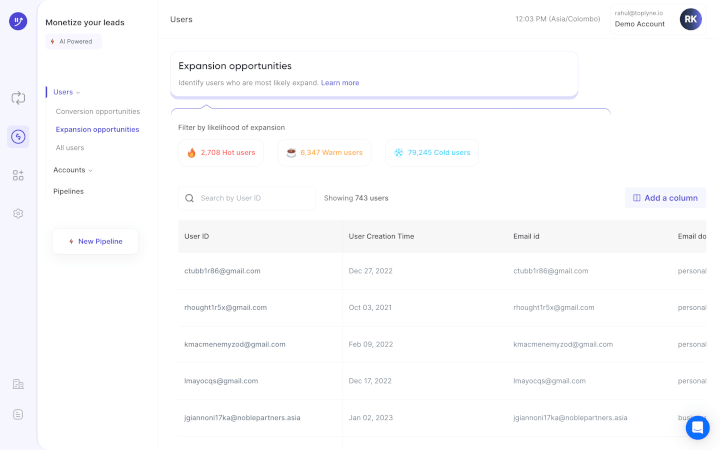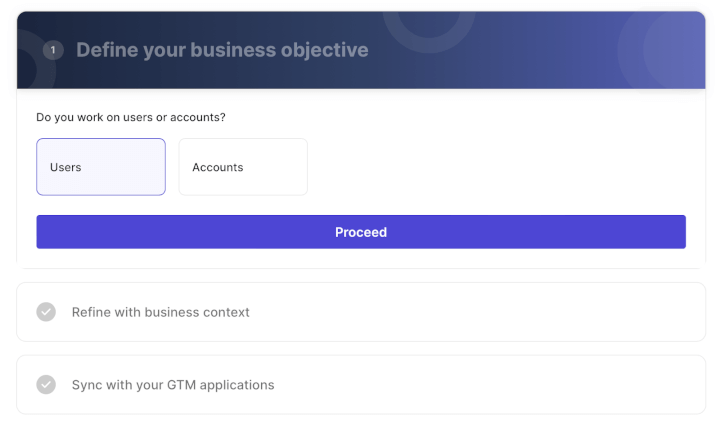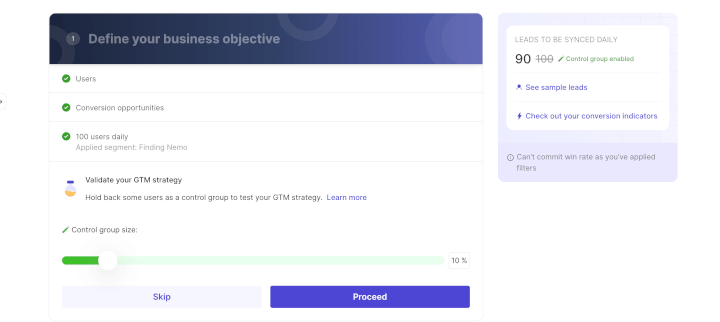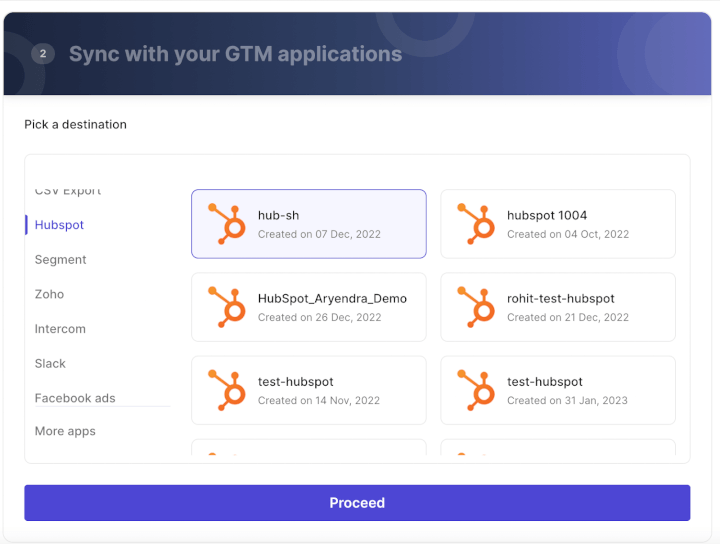Sales Qualified Lead Vs. Opportunity: What’s the Difference?

Comparing a sales qualified lead vs opportunity is like comparing a person browsing 👀 a menu at a restaurant versus someone who's summoning the waiter 🙋
In the inbound marketing world, that means: One's still exploring options, and the other is ready to purchase.
But how can you tell the difference? 🤔
And how does this impact your bottom line? 💰
This post will unpack everything you need to know, starting with a quick overview of the buyer’s journey, after which we’ll dive into the differences between a sales qualified lead and an opportunity.
We’ll then explore why sales qualified leads are essential for a healthy sales pipeline and how you can convert a lead to a sales qualified lead and a sales qualified lead to an opportunity.
But that’s not all.
We’ll also shed light on a one-of-a-kind tool to help you build a consistent pipeline of sales opportunities.
Ready to be served?
A Quick Overview of the Buyer’s Journey
Before diving into the differences between a potential client browsing your menu versus one who’s ready to place an order, let’s understand how they may find their way to your restaurant 📍

Here’s a quick glimpse into the B2C and B2B sales funnel:
- Awareness: Like many great philosophers have said, awareness 🧘is always the first step. Similarly, the first stage of lead conversion is when a lead becomes aware of your product or service (at the top of the sales funnel).
Awareness can happen through various B2C and B2B marketing channels 📢 or strategies, such as social media, advertising, content marketing, or some good old friends (word-of-mouth).
- Interest: If your marketing campaign or strategy catches the lead’s interest, they may further educate themselves by visiting your website or reading your blog content. Here, a lead becomes a qualified prospect or marketing qualified lead (MQL) ✅
Personalized communication or a discovery call, at this point, helps nurture and move them further down the marketing funnel.
You’ve got to make them drool! 🤤
- Consideration: At this stage, a qualified prospect or marketing qualified lead begins comparing 📝 your products or services to competitors, reading reviews, or requesting more information.
When this happens, the prospect or marketing qualified lead becomes a sales qualified lead or sales accepted lead.
- Intent and evaluation: When a sales accepted lead has decided to purchase 💸 or is ready to take action, they become a sales qualified opportunity. They may visit your pricing page multiple times, register for a product demo, contact your sales team, and more.
- Purchase: Finally, sales qualified opportunities purchase your product or service and become customers — a match made in SaaS heaven ♥️
Let's look at the defining characteristics of a sales qualified lead vs. a sales opportunity.
Sales Qualified Lead Vs Opportunity: What’s the Difference?
Sales qualified lead and sales opportunity are inbound marketing terms often used interchangeably but have distinct characteristics.

Nope!
The following pointers will clear the confusion:
1. Sales Qualified Lead
A sales qualified lead (SQL) is a sales prospect who fits your ideal customer profile. These leads typically have a high lead score and have engaged more heavily with your brand than marketing qualified leads.
Some common SQL traits include:
- They have a clear need or problem that your product or service can solve.
- They have the budget and authority to make a purchasing decision.
- They have a timeline for making a purchasing decision.
- They may have viewed your pricing page several times, filled in a form on your website, attended a webinar, and more.
2. Sales Qualified Opportunity
When a sales qualified lead moves further down the sales pipeline or marketing funnel, they become a sales qualified opportunity. The leads in the opportunity stage are almost ready to purchase, and they’ll usually request product demos, negotiate terms with stakeholders, schedule meetings, and more.
Some defining characteristics of a sales qualified opportunity include:
- They clearly understand how your product or service can solve their problem.
- They have an adequate budget and are ready to make a purchasing decision.
- They have a timeline for purchasing and are actively working to make that happen.
- They have communicated with the sales team and have a strong relationship with them.
Let’s find out the importance of identifying sales qualified leads.
Why Are Sales Qualified Leads Essential for a Healthy Sales Pipeline?
By identifying 🔎 and qualifying leads as SQLs, you can optimize your lead generation strategies and qualification criteria, improve your team’s overall productivity, and gain valuable customer insights.

Let us show you how:
- Improve productivity: Identifying sales qualified leads helps your team prioritize their sales and marketing efforts, time, and resources on engaging with leads more likely to convert into paying customers.
As a result, you improve productivity by reducing the number of leads that need to be engaged before closing a sale.
The best part?
It significantly shortens your average sales cycle length and boosts your sales win rate 👯
- Gather deeper insights: By analyzing and qualifying leads, your sales and marketing team can uncover patterns and insights related to the SQL's demographic, firmographic, and behavioral data.
More importantly, you can derive valuable information about their pain points, budgets, timelines, and the solutions they seek.
It’s like gazing into the future 🔮
- Optimize your sales strategies: Based on the insights and analysis derived from sales qualified leads, you can customize your sales process and marketing efforts to increase your chances of success 💯
For example, insights from sales qualified leads can help you quickly identify the best-performing content, ads, and marketing platforms. You can then refine your buyer persona, lead qualification criteria, messaging, and targeting accordingly.
Want to know how to convert a lead into a sales-qualified lead?
Let’s find out!
How to Convert a Lead into a Sales Qualified Lead
Converting a lead into a sales qualified lead involves nurturing the lead through various stages of the sales funnel.
That means you need to sow the right seeds, give them water, sunshine, and nutrients, and watch them grow!

Here are some tried-and-tested tips:
1. Understand Your Ideal Customer Profile
Understanding your ideal customer profile 👤 is an integral part of sales prospecting.
So, identify common attributes like industry, company size, geographic location, pain points, and goals of a sales lead who’s gone on to purchase your product or service.
2. Qualify the Prospect
Once you have identified a potential customer, you’ll need to qualify them.
To do this, you'll need lead qualification or scoring criteria — assigning data points based on the prospect's demographic and behavioral characteristics.
How to assign point values in lead scoring?
You’ll need to consider the relative importance of each factor to your business and sales process.
For example, your lead qualification criteria could attribute 5 points for a lead's job title, 10 points for their company size, and 15 points for a demo request.
The final lead score could help you determine if the sales prospect is a good fit or an unqualified lead.
Pssst… your qualification process must also ensure your sales prospect has the authority to purchase.
3. Nurture the Prospect
The next step in the lead management process involves nurturing a sales lead. This means providing valuable content, such as case studies, whitepapers, and webinars, demonstrating how your product or service can solve their problems.
You must also engage with your prospects regularly through phone calls, emails, and social media to build a relationship🤝and stay top of mind.
What is the best approach to converting sales-qualified leads into opportunities?
Don’t worry! We’ve got the answers.
How to Convert a Sales Qualified Lead into an Opportunity
Sales qualified leads that have moved to the opportunity stage display a clear interest or intent in purchasing your product or service and could become customers.
They also present an excellent opportunity to upsell and cross-sell tailor-fit solutions.

Keep these lead management tips in mind:
1. Identify Your Customers' Needs
Before you begin nurturing a sales qualified lead into a sales qualified opportunity, it's essential to understand the customer's needs.
So, evaluate what makes your product or service a good fit for your customers and how it helps them solve problems or achieve their goals.
2. Provide a Compelling Demo
Schedule a date and time for a product demonstration or trial, allowing your customer to see the benefits or advantages of your product or service.
Remember to keep your customers engaged by providing time for feedback and questions.
3. Address Any Concerns
If your customers raise concerns or objections, addressing how your product or service is the right solution for them is essential.
Ideally, you must present case studies or use cases via email to reassure them. Or, consider implementing tweaks to your product, service, pricing, etc., to meet their requirements.
4. Formulate a Customized Proposal
If the customer is a qualified opportunity, the next step is to provide them with a proposal✍️ that outlines the benefits of your product or service and the terms of the deal.
The proposal should be tailored to the customer's specific needs and pain points, showcasing how your solution can solve their problems and bring value to their business.
5. Close the Sale
The sales rep secures the deal with the customer during the final stage of the lead conversion or sales process.
It involves negotiation, finalizing the contract, and agreeing to the terms and conditions of the sale.
Once the sale is closed, ensure your sales rep follows up with the customer to gauge their satisfaction with the product or service, address any concerns or issues, and maintain a relationship with them for future sales opportunities.
Now you may be wondering:
Is there an easier way to qualify leads and convert them?
Build a Consistent Pipeline of Product Qualified Leads with Toplyne
Evaluating and scoring leads can help your sales team reduce time and effort and increase their chances of converting sales qualified leads into opportunities.
But what if you want to boost your sales team’s productivity further?
Have no fear. Product qualified leads are here!

A product qualified lead is a potential customer who has experienced your product's value firsthand via a free trial or a limited-feature freemium model.
As a result, a product qualified lead has a high probability of converting into a paid customer.
This also translates to a shorter sales cycle and lowers customer acquisition costs thanks to less intervention from your sales development rep and marketing team.
So how do you establish robust qualification criteria?
The easiest way is by using a kickass tool like Toplyne.
Toplyne is a one-of-a-kind tool using AI-powered technology to help you build a pipeline of product qualified leads.
The result?
It allows your sales development rep to focus on the most promising prospects, sending your sales win rate through the roof 🚀
Here’s how companies like Pitch and Vercel generate sales pipeline from their self-serve funnel using Toplyne:
- Step 1/7: Create monetization playbooks to surface conversion and expansion opportunities (leads most likely to convert to paying customers, and teams most likely to grow into larger teams)

- Step 2/7: Choose the right leads to target – users (individual users) or accounts (a group of users with an organization).

- Step 3/7: Select the frequency at which you would want leads synced in your GTM apps.

- Step 4/7: Define how many leads you want by either the number of leads or your expected win rate, depending on your sales capacity and GTM strategy.

- Step 5/7: Build custom segments - Build custom segments based on And/Or logic at the deepest level of sub-properties within your product analytics.

- Step 6/7: Validate your GTM strategy - Hold back some users as a control group to test your GTM strategy.

- Step 7/7: Sync your product qualified pipeline into your GTM destinations - CRMs, sales & marketing execution tools, and customer engagement platforms.

Capture Sales Qualified Opportunities Like a Pro Surfer Catches the Perfect Wave
Spotting and nurturing sales qualified leads into opportunities can skyrocket your sales win rate.
But without a lead scoring tool, it can make you feel like an amateur surfer bobbing around in the middle of the ocean — watching wave after wave (sales qualified opportunities) pass you by.
Luckily, with a headless sales AI tool like Toplyne, identifying and nurturing a quality lead into a sales opportunity is as easy as a pro surfer riding the perfect wave 🏄
How?
Toplyne's proprietary behavioral AI engine combines your lead record or data from product analytics, CRM, billing, etc., with third-party enrichment data to find you the most promising leads.
The result?
You can quickly identify and target high-intent customers with precision.
So, sign up for a free Toplyne demo today and make waves with your sales conversion rates.



.svg)









.png)